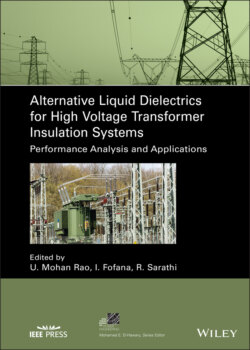Читать книгу Alternative Liquid Dielectrics for High Voltage Transformer Insulation Systems - Группа авторов - Страница 45
2.4.1.2.2 Series Representation
ОглавлениеThe application of an AC sinusoidal voltage source to the lossy dielectric in series combination with resistance Rs and capacitance Cs gives two components of voltage and across the resistor and capacitor, respectively, as seen in Figure 2.6c. The power factor angle is represented by φ in Figure 2.6d. The cotangent of the power factor angle is given by the equation:
(2.4)
So, the loss tangent may be written as:
(2.5)
The power loss is given by:
(2.6)
(2.7)
(2.8)
From both representations, the loss is expressed in terms of the capacitance (C) and the loss angle (tan δ ). Therefore, the factor Ctan δ is an important parameter to ascertain the quality of an insulating medium.
For a nonideal dielectric, the δ angle is greater than 0°. This happens because of the existence of some contaminants and some conducting channel is formed in the dielectric. An increase in the value of tan δ indicates that the oil is contaminated because of oxidation and aging and ingress of excess moisture. Generally, it is not possible to have an ideal dielectric in nature. Due to some kind of impurity, a dielectric always has a loss angle less than 90°. The temperature significantly increases when the power dissipation is higher. The lower the DDF value, the better the integrity of the oil. Higher DDF values indicate the presence of contaminations in the oil. Formation of sludge and water leads to decay in dielectric properties in due course of time and increases the DDF value. Better dielectric properties can be achieved when minimum moisture is contained in the insulating oil. Many studies have shown that with aging, the dielectric properties degrade and this results in the increase of the DDF [55]. Oxidation reaction in the oil produces a variety of by‐products, in which some of them further form acids, sludge, and suspended particles [56]. DDF is a measure of the polarity of the oil molecules, and so NEOs cannot be directly equated with MOs, because the nature of the polarity in the triglyceride molecules of NEOs is different than MOs.
